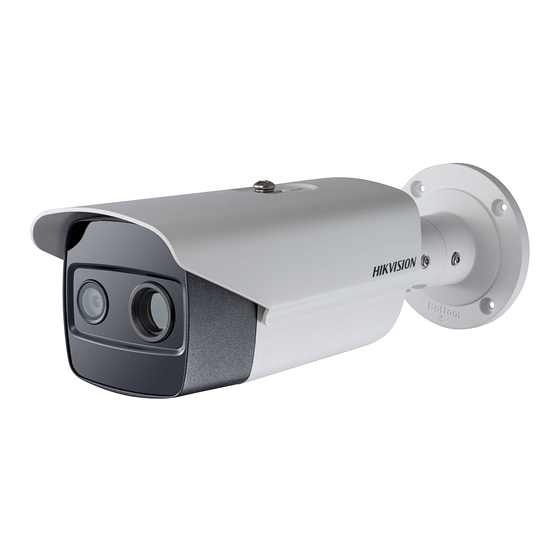
Table of Contents
Advertisement
Quick Links
Advertisement
Table of Contents

Summarization of Contents
Chapter 1 Overview
1.1 Brief Description
Provides a high-level overview of the thermal and optical bi-spectrum network camera's capabilities.
1.2 Function
Introduces the main functionalities of the device, including fire detection and temperature measurement.
Chapter 2 Device Activation and Accessing
2.1 Activate the Device via SADP
Guides users on activating the device using the SADP software for initial setup.
2.2 Activate the Device via Browser
Explains the process of activating the device through a web browser interface.
2.3 Login
Details how to log into the device via its web browser interface after activation.
2.3.1 Install Plug-in
Instructs on installing necessary browser plug-ins for accessing device features.
Chapter 3 Temperature Measurement
3.1 Notice
Provides important notices and recommendations for accurate temperature measurement configuration.
3.2 Thermography Configuration Flow Chart
Presents a visual flowchart illustrating the process of configuring temperature measurement.
3.3 Automatic Thermography
Explains how to configure automatic temperature measurement and alarm rules.
3.3.1 Set Thermography Parameters
Details the parameters for configuring temperature measurement, including display options.
Chapter 4 Fire Source Detection
4.1 Recommended Scene
Suggests optimal installation scenarios for effective fire source detection.
4.2 Set Fire Detection Parameters
Details how to configure parameters for the dynamic fire source detection function.
Chapter 5 Perimeter Protection
5.1 Flow Chart of Perimeter Protection
Provides a flowchart outlining the steps for configuring perimeter protection.
5.2 Set VCA Parameters
Explains how to configure Video Content Analysis (VCA) parameters for detection rules.
5.3 Calibration
Covers the process of calibrating the camera for accurate VCA measurements.
5.3.1 Calibrate Automatically
Guides on performing automatic camera calibration using a person's height.
Chapter 6 Event and Alarm
6.1 Set Motion Detection
Explains how to configure motion detection to trigger linkage actions.
6.1.1 Normal Mode
Details setting motion detection parameters in the normal configuration mode.
6.1.2 Expert Mode
Covers advanced motion detection settings, including day/night switch and sensitivity.
6.2 Set Video Tampering Alarm
Describes how to set up alarms for video tampering or obstruction.
Chapter 7 Arming Schedule and Alarm Linkage
7.1 Set Arming Schedule
Allows users to define specific time periods for device tasks and alarms.
7.2 Linkage Method Settings
Explains how to configure responses when an event or alarm occurs.
7.2.1 Trigger Alarm Output
Guides on configuring the device to send signals to external alarm output devices.
7.2.2 FTP/NAS/Memory Card Uploading
Describes setting up storage for alarm information on FTP, NAS, or memory cards.
Chapter 8 Live View
8.1 Live View Parameters
Covers settings related to displaying live video feeds from the camera.
8.1.1 Window Division
Explains options for dividing the live view screen into multiple windows.
8.1.2 Live View Stream Type
Guides on selecting the appropriate stream type for live viewing.
8.1.3 Enable and Disable Live View
Describes how to quickly start or stop live view for all channels.
Chapter 9 Video and Audio
9.1 Video Settings
Details the configuration of video parameters like stream type, encoding, and resolution.
9.1.1 Stream Type
Explains the different stream types (Main, Sub, Other) and their characteristics.
9.1.2 Video Type
Guides on selecting whether to include audio content in the video stream.
9.1.3 Resolution
Covers selecting video resolution based on bandwidth and storage needs.
Chapter 10 Video Recording and Picture Capture
10.1 Storage Settings
Covers configuring storage options like memory cards, NAS, and FTP.
10.1.1 Set Memory Card
Guides on inserting, formatting, and managing memory cards for storage.
10.1.2 Set NAS
Explains how to configure Network Attached Storage (NAS) for recording files.
10.1.3 Set FTP
Details setting up an FTP server for saving captured images and data.
Chapter 11 Network Settings
11.1 TCP/IP
Covers essential TCP/IP configuration for network connectivity, including IPv4 and IPv6.
11.2 Port
Details how to configure various ports (HTTP, HTTPS, RTSP, Server) for network access.
11.3 Port Mapping
Guides on setting up port mapping for accessing devices across networks.
11.6 Access to Device via Domain Name
Guides on accessing the device using a domain name via DDNS.
Chapter 12 System and Security
12.1 View Device Information
Details how to view essential device information like model, serial number, and firmware version.
12.2 Search and Manage Log
Guides on locating and troubleshooting issues by searching and managing system logs.
12.3 Import and Export Configuration File
Explains how to import/export configuration files for batch setup and backup.
12.6 Restore and Default
Guides on restoring device parameters to default or factory settings.
Chapter 13 Appendix
13.1 Common Material Emissivity Reference
Provides a reference table of material emissivity values for thermal imaging.
13.2 Device Command
Directs users to a QR code for accessing device serial port commands.
13.3 Device Communication Matrix
Points users to a QR code for device communication matrix information.








Need help?
Do you have a question about the DS-2TD1217-2/P and is the answer not in the manual?
Questions and answers